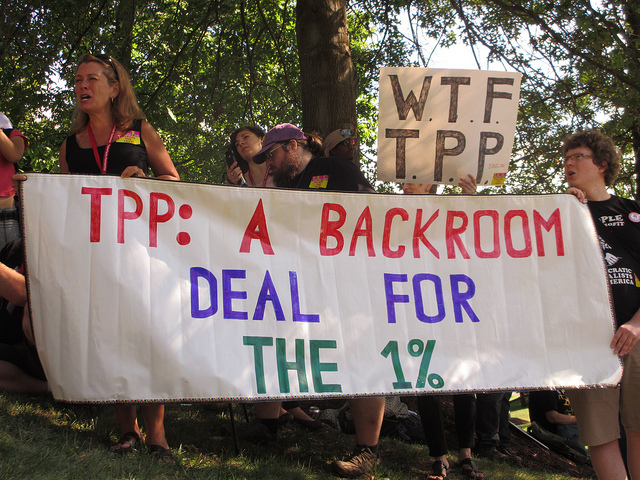Like this article? rabble is reader-supported journalism. Chip in to keep stories like these coming.
With 14 days to go in the election campaign, Stephen Harper announced the conclusion of the Trans-Pacific Partnership (TPP) agreement, a comprehensive economic integration deal pushed by the U.S., that will cover 12 countries including Japan, but excluding China.
The TPP constructs an American-led trade bloc aimed at China. It is protectionist: designed to inhibit Chinese encroachment into advanced trade areas such as patents and trademarks, pharmaceuticals, digital software, telecommunications, and government procurement.
In the world envisaged by the TPP, China (or Russia) will trade with its Pacific neighbours on terms agreeable to American multinationals.
American corporations want to ensure that lucrative private services trade remains an American advantage, and that public services are restricted in areas such as health care or education. Limiting the reach of Chinese State-Owned Enterprises inside the bloc is an important objective.
Canada followed U.S. leadership in negotiating the TPP without undertaking serious public consultation on the issues at stake. Canada already has trade agreements with four of the 12 countries accounting for 75 per cent of the GDP of the TPP countries, so it is important to discover what new ground has been broken by this deal.
While the Office of the United States Trade Representative provided a summary of the 30 TPP chapters, the Conservatives issued a press release with an out-of-date backgrounder.
In selling the deal to Canadians, Harper has resorted to Brian Mulroney trade tricks used with some success in the 1988 debate over the Canada-U.S. trade deal. First, he hoists the flag: Canadians can compete on a level playing field with any other country. Second, he accuses critics of being against trade when they point out serious flaws in the deal. Third, Harper like Mulroney ignores the wrong-headedness of importing the American economic model (and its social counterpart) disguised as a trade agreement.
The TPP provides for the removal of conventional tariffs on goods, already low to insignificant because of multiple rounds of trade talks since 1947. It also contains surprises yet to be revealed in any detail that will notably guarantee long-term monopoly prices for U.S. biotech products and drugs, limit Crown corporations like the CBC, restrict public sector spending, kill buy local programs, hamstring industrial policy, and sabotage supply management of agriculture.
Canadian farmers are promised substantial compensation for their losses, over many years, even as Harper pretends there will be no losses. Nothing similar is mentioned for Ontario autoworkers who look to be the first big TPP loser, as domestic content for auto parts and cars assembled in Canada will be cut back by about 40 per cent, putting over 80,000 well-paying jobs and an entire industry at risk.
NDP leader Tom Mulcair has pledged to scrap the deal, which he points out the government had no mandate to sign in secret during an election campaign.
It is unprecedented for a Canadian prime minister to approve a major undertaking towards the end of an election. In his role as leader of a party seeking a new mandate from the people, the Harper government’s actions would normally be limited to routine business.
Justin Trudeau promises a full and open debate, not exactly reassuring to those who remember how Liberal leader Jean Chrétien promised to re-negotiate NAFTA during the 1993 election, only to give in to Washington once elected.
The reality of trade deals such as TPP or NAFTA (which it will supersede) is that they encourage outsourcing of production to lowest-wage jurisdictions and suppress wages at home. Multinational corporations are happy to export back to Canada goods which were formerly produced here. Formerly employed workers bear the brunt of so-called trade “adjustment.”
The TPP is the most recent of what University of Toronto political scientist Stephen Clarkson has identified as “external constitutions“: international accords (misleadingly named free trade) to limit domestic parliaments’, legislatures’, and municipal councils’ right to legislate in the public interest.
The power of giant corporations to protect and advance ownership rights over jobs, wages and labour rights has been enshrined in NAFTA, the WTO and a series of 23 bilateral trade and investment deals negotiated by the Harper Cons. This is how the class struggle is waged from above.
These trade deals represent “Charters of Business Rights and Freedoms,” including the right to sue governments for non-performance of obligations to protect business profits. Under what are falsely labelled trade agreements, regulations deemed unfriendly to business, such as restrictions on financial institutions, are prohibited.
Investor-state dispute settlement amounts to a privatization of the law, putting a prosecutor’s robe on corporate lawyers and allowing them to charge governments for committing crimes against private property, while corporate criminals get away scot-free.
Despite mountains of propaganda favouring the benefits of corporate trade deals, the Canadian public is not buying into the idea. An online survey conducted in August for the localparliament.ca project asked Canadians if there “should be more free trade with other countries, even if it hurts some industries in Canada.” Reporting results on Twitter, Professor Peter Loewen remarked: “Even for Tories, there is more disagreement than agreement (39 per cent vs. 28 per cent). Greater differences among Lib (41 per cent vs. 25 per cent) and NDP (47 per cent vs. 18 per cent).”
In other words, what hurts Canadians is bad policy, and has little public support.
Duncan Cameron is the president of rabble.ca and writes a weekly column on politics and current affairs.
Photo: GlobalTradeWatch/flickr
Like this article? rabble is reader-supported journalism. Chip in to keep stories like these coming.



